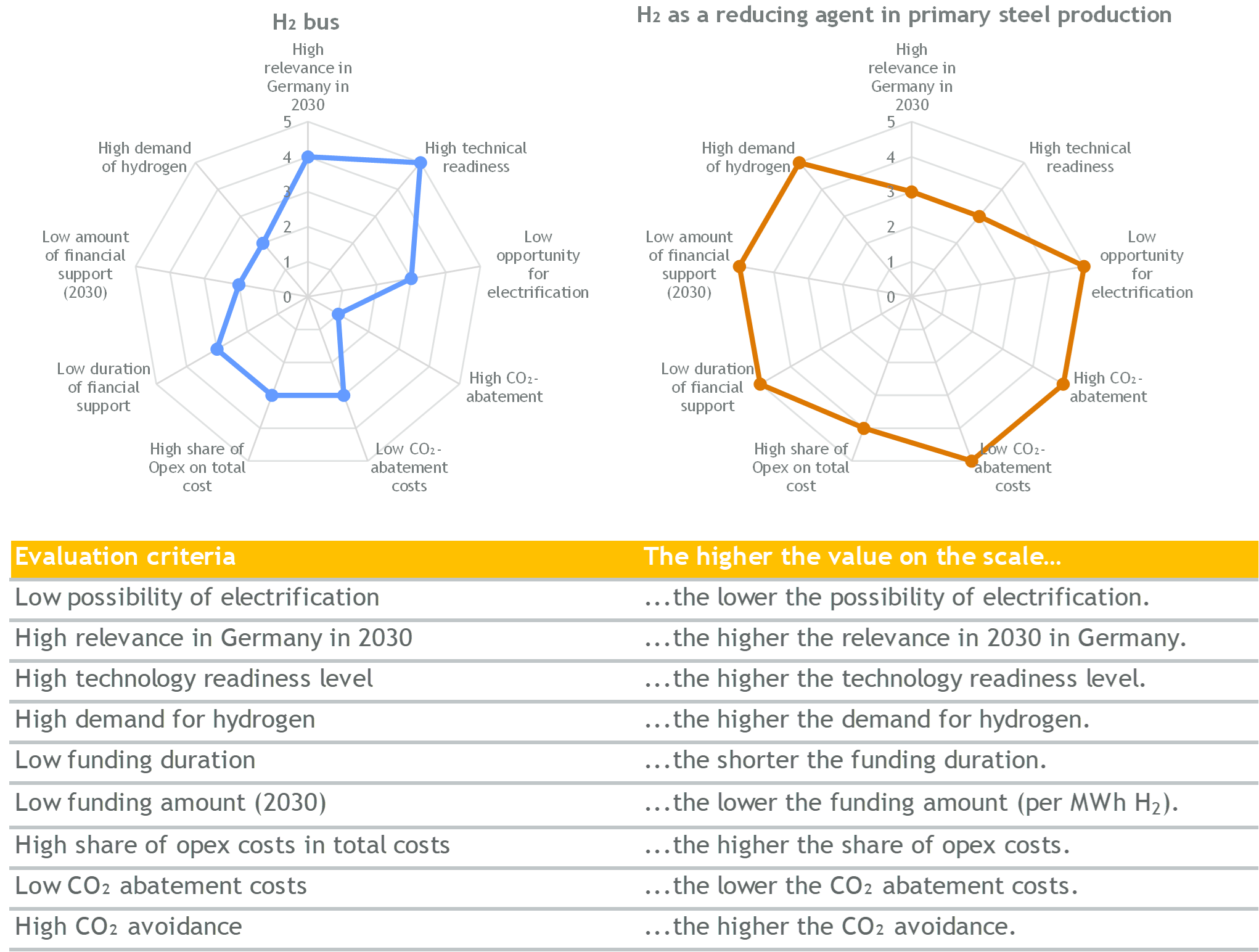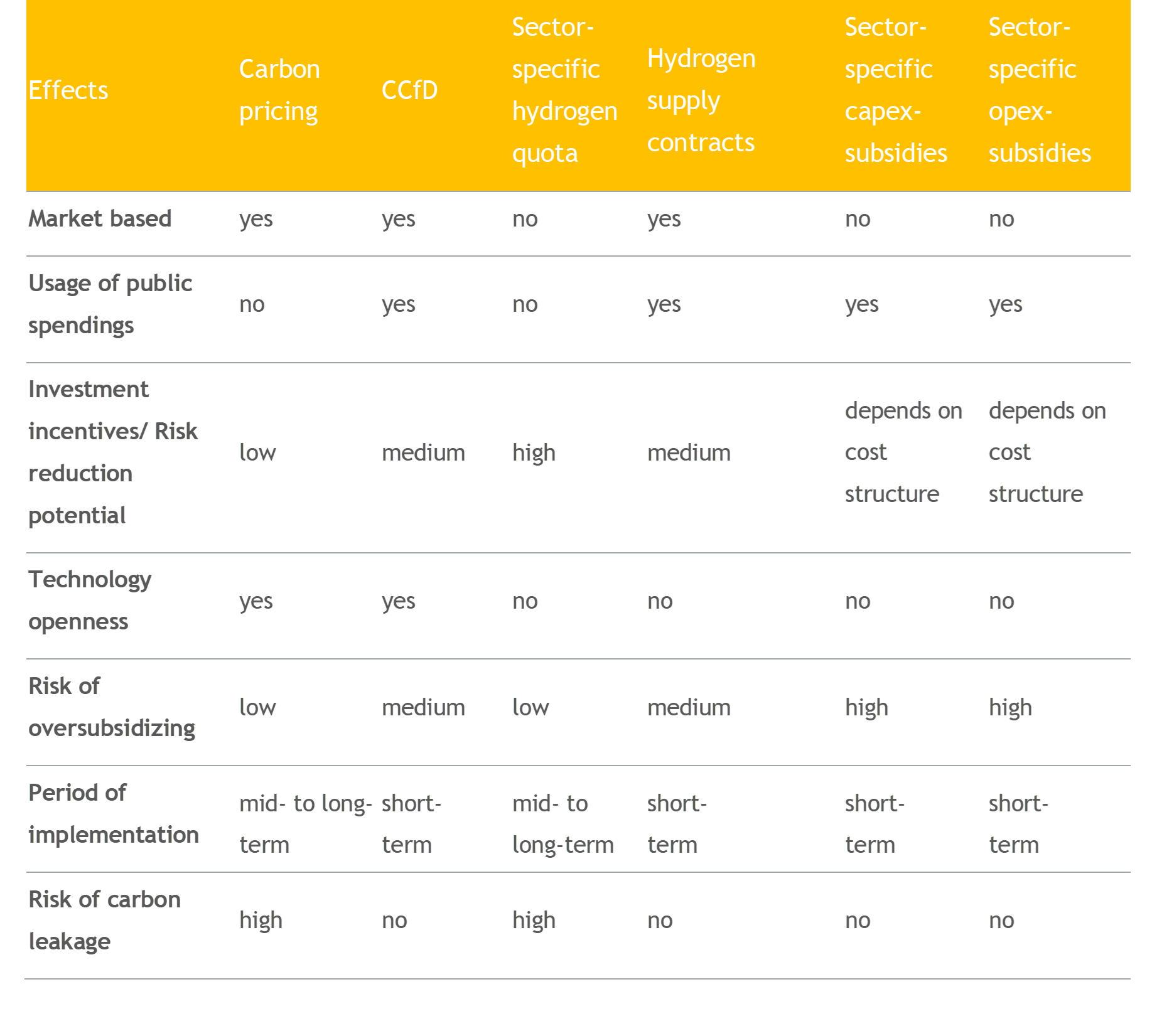
Buses, steel or blending in gas-fired power plants: Green hydrogen can be used in many areas – but which applications and which funding instruments can be used to efficiently drive the market ramp-up in the short term? That depends on various criteria – for example, whether the application could also be electrified as an alternative, the CO2 abatement costs, or how far the application is from being economically viable.
Which applications are suitable for the market ramp-up of green hydrogen, to what extent state subsidies might be necessary, how these can drive a market ramp-up with the least possible distorting effects, and which criteria and instruments play a role in the funding, are shown by the Energy Economics Institute at the University of Cologne (EWI) in the study ” H2 funding compass – Criteria and instruments for the support of hydrogen market ramp-up applications”. The publication was produced on behalf of the “Funding initiative hydrogen“ of the Gesellschaft zur Förderung des Energiewirtschaftlichen Instituts an der Universität zu Köln e.V.
Green hydrogen can be used in all sectors. Of particular importance for the market ramp-up are applications that already have an advanced level of technology readiness, such as fuel cell trucks, trains or buses, or existing industrial processes in which gray hydrogen can be replaced by green hydrogen, for example in the production of hydrogen peroxide. However, according to the EWI study, none of the applications is yet competitive compared to their respective conventional alternative. However, according to the National Hydrogen Strategy, the German government expects hydrogen demand to reach 90 to 110 TWh by 2030. To achieve these targets, the market ramp-up would have to be accelerated and greater investments would have to be made in hydrogen applications than has been the case to date. In this case, the current lack of economic viability could be compensated by state funding.
Policy makers are therefore faced with the question of which applications should be supported. According to the EWI analysis, this question depends on several criteria. The study examined a total of twelve different applications with regard to nine different criteria. Figure 1 shows an example of the evaluation for the use of hydrogen in buses and in primary steel production. Ten other applications are examined in the study. The higher the value on the scale, the more attractive the application is for use in the market ramp-up of hydrogen and thus as a replacement for the conventional alternative.

The figures clearly show that hydrogen buses already have a high level of technology maturity. Hydrogen buses already have a high level of technological maturity. However, a single bus has a rather low potential to save CO2, while the CO2 abatement costs are in the mid-range. At the same time, a rather high funding amount (per generated demand volume) would be needed, even if only over a medium time period. The generated demand for hydrogen by a bus is rather low, but could be increased by converting a bus fleet.
The use of hydrogen as a reducing agent in primary steelmaking, on the in contrast, exhibits medium technology readiness. The use of hydrogen can save larger quantities of CO2. In addition, it would have to be funded with less money and only for a short period of time. Overall CO2 abatement costs would be low. The generated demand for hydrogen would be very high.
“Policymakers have to weigh how they weight the criteria,” says Lena Pickert, senior research consultant at EWI, who co-authored the study with Patricia Wild, Konstantin Gruber and Niklas Schoch. “For a particularly fast market ramp-up, for example, the technology readiness and the overall generated demand for hydrogen could be important criteria, although possible lock-in effects with existing electrification alternatives have to be taken into account here.”
The EWI team also investigated which market-based or regulatory instruments could be used to support short-term hydrogen demand. “An appropriate CO₂ pricing of conventional alternatives represents the basis of any funding,” says Pickert. In addition to CO2 pricing, five other instruments were examined.

The study shows that the funding instruments examined have different effects and modes of action. Table 1 shows which potential the funding instruments have, e.g. for reducing investment risk, or which risks exist, e.g. with regard to carbon leakage. As a central element of the funding of green hydrogen, the double auction model is suitable, as it supports the creation of a market for large quantities of hydrogen and can cover the gap between costs and willingness to pay on a competitive basis. Here, for a fixed quantity of green hydrogen, an intermediary matches the producer with the lowest price to the buyer with the greatest willingness to pay. The intermediary covers the remaining differential costs and thus closes the cost gap between production costs and willingness to pay. Through long-term purchase contracts between the hydrogen producer and the intermediary, investment security is ensured.
When choosing the funding instrument, however, it should be noted that end-use applications differ specifically in terms of cost structures. While high investment costs are the decisive obstacle for large industrial applications, the economic viability of other applications fails primarily due to the operational expenses for the use of green hydrogen, for example, in the case of existing material demand or blending into the natural gas grid. In particular, the price of hydrogen has a major impact on the economic viability of applications with low investment costs. “A support concept should take this diversity into account through a mix of different instruments,” says Pickert.